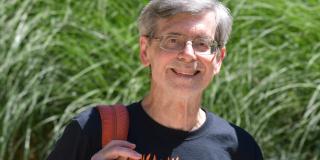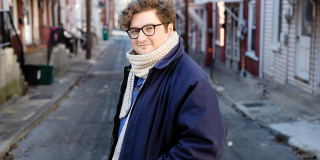
Ph.D. student explores the literary intersection of health and horror
Bodily mutilation. Flesh-eating bacteria. A highly contagious virus of unknown origin. Any of these conditions has the makings of a blockbuster horror film or bestselling novel. They all have their roots in our real-life health and medical communities. Gillian Andrews, a Ph.D. student in the Department of English, explores the overlap between the horror genre and health humanities in her dissertation, Haunting Health: Disease, the Horror Genre and Health Rhetoric.
Andrews’ interest in the horror genre began long before she came to Lehigh as an exchange student from her native England.
“I always really liked horror. I think I got into it slightly too young as a teen,” she said with a laugh.
She chose Lehigh from a list of U.S. schools. She returned home and earned her B.A. in comparative literature from University of Kent, Canterbury, England, and came back to the States and received her M.A. in English from Lehigh.
“Coming to the U.S. has been a big change, but it’s been wonderful,” she said.
A college adviser piqued Andrews’ interest in the health humanities. Along with the interest in horror, she began asking more questions and doing more research on how the two genres intersect. It eventually became her dissertation topic.
Andrews is in a relatively small group of academics studying the overlap of horror and health humanities.
“On one hand, you have to love what you do,” she said. “If you don’t love the subject, you will suffer. I also chose this topic because the intersection of health humanities and society is a growing field, so there was a practical consideration.”
And, she said, the horror genre is largely under-explored in health humanities, with much more research in science fiction.
“[Science fiction] is great because it helps us imagine the future, but horror is sometimes still kind of looked down upon as not very academic, with not much to offer. There’s not as much exploration about fear,” she explains. “Some people have theorized why the horror genre exists. It’s a cathartic experience—where everything society shoves aside surges up, then gets put to bed at the end of the story.”
She agrees it’s a little fun to be scared—“engaging with taboo topics in a safe, contained narrative,” she said. As horror fans would agree, there is something oddly satisfying about having a good scare—not knowing what’s around the corner or when the ominous figure might emerge on the page or screen. The protagonist typically faces the monster or ominous figure head-on. In the health community, the fear largely stems from the unknown, whether waiting for more information about a diagnosis, a course of treatment or an approximate prognosis. Even terms from horror books and films are now widely used to describe health conditions or medicinal side effects, such as feeling like a “zombie.”
The basic human emotion of fear is a common thread in conversations about both the horror genre and health humanities topics. Fear and anxiety as medical conditions have been studied and researched extensively, but less when it comes to their connection to horror film and literary genres. Andrews felt it was important to add her own perspective to these conversations.
“Horror can sometimes be looked at as a kind of ‘thrills and chills’ genre that doesn’t say much or is viewed as a less valuable genre,” she said. “And in the health humanities area, there hasn’t been much publication as to how they fit together.”
Yet, Andrews points out, a depiction of our shared fears can teach us about what a culture values.
“In horror, we’re shown how often those shared anxieties center around the body. I think that’s an important idea for health humanities, and medicine more broadly, to examine,” she said.
Specifically, Andrews suggests contemporary horror films can help health humanities discuss three particularly complex issues: contagion and the associated violation of bodily and social boundaries; the history and current reality of racial abuse and exploitation in medicine, and psychological trauma and its medicalization.
“I look at racial exploitation of black bodies specifically. For me it was ethically important to not have an all-white dissertation,” she said.
She mentions Jordan Peele’s 2017 film Get Out as an example of a work by a black filmmaker that speaks to the intersection of health and horror. The film centers on Chris and Rose, a young interracial couple who have reached the “meeting the parents” stage of their relationship. Chris is invited to a weekend getaway with Rose’s parents. What Chris writes off as overly accommodating behavior on the part of Rose’s family becomes something much more sinister.
“It was such a massive success and helped this social horror sub-genre gain a lot of momentum,” Andrews explains.
She cites the 1973 classic The Exorcist—one of her personal favorites —as a prime example of how the overlap of horror and health care are perceived. In the film, 12-year-old Regan MacNeil (Linda Blair) starts acting strangely, then gradually more aggressive and terrifying. Her actress mother, Chris MacNeil (Ellen Burstyn), seeks answers from a host of doctors. The medical professionals run a battery of tests, including one scene showing a spinal tap that could make a viewer with the heartiest constitution squirm.
“That’s a lot of what makes people flinch—sometimes, the medical procedures come off as more scary,” Andrews said.
Finding no medical explanation but suspecting something deeper and perhaps more sinister, one physician suggests Chris enlist the help of a priest, fearing Regan’s symptoms and behavior could be the result of demonic possession. Andrews’ other favorites include the Saw and Hostel films because of their “meditations on the vulnerability and instability of the human body” and the Friday the 13th and A Nightmare on Elm Street franchises, with their portrayals of life in and around suburbia and strong focus on high school culture.
In the case of life imitating art, the COVID-19 pandemic was the ideal intersection of horror and the health humanities. Andrews said the pandemic had a profound effect on her both personally and professionally. “It all became very real,” she said. “Dealing with such serious topics in my research, then having it come crashing down in my world—it made it very heavy for me but brought a lot of analysis opportunities which were public-facing.” As in many horror films, fear and uncertainty divide the general public: “I read a think piece that included a quote from John Carpenter’s The Thing (1982) which said, ‘Nobody trusts anyone anymore, and we are all very tired.’ There are more examples of recent films merging contagion with social commentary. Another film, It Comes at Night (2017), shows how people turn on each other in the face of disease. Likewise, characters like Dr. Frankenstein in Mary Shelley’s Frankenstein have shaped our perception of physicians. This mistrust of medicine [that emerged during COVID-19] has been a cultural touchstone for some time.”
The extensive news coverage of the virus heightened the public’s fears. It also raised new questions for some about the validity of science and medicine and made terms steeped in the horror genres, like “zombie” and “ghoulish”, part of the public vocabulary. “If you felt like a different person, like you’ve had such a shift, maybe you described yourself as ‘feeling like a zombie’—it gives you rhetorical power,” she said. “I’ve seen people online use these phrases to describe their conditions. It shows how the horror tropes and language are being evoked.” Horror films and literary works include portrayals of many common fears, yet they also offer a safe way to start important conversations about illness, life, and death.
Andrews hopes to further explore her interests in an academic setting. She currently teaches courses in the Health, Medicine and Society program, focusing on health and humanities. This allows her to explore more of her interests in the field.
“I would love to teach similar things in either an HMS-type program, or in a similar program based in medical schools, teaching humanities literacy to medical students,” she said.
She is also open to working in a non-academic position that has a focus on health.
Horror films and novels have evolved to focus on more psychological aspects, further blurring the lines between the genre and the health humanities. Andrews’ research is one of the many conversations focused on exploring the ever-deepening connection between the two.
by Sara Karnish






